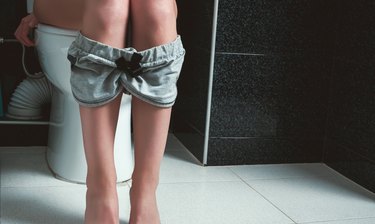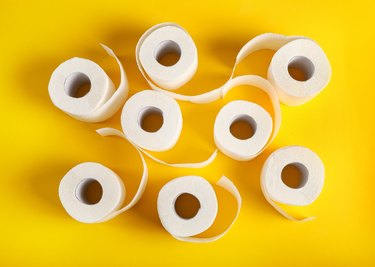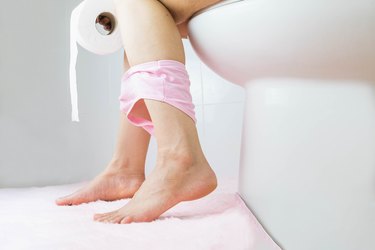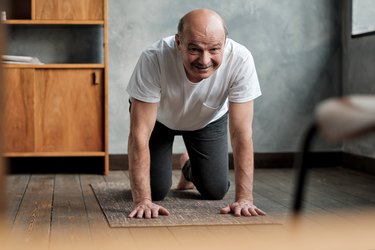
Waking up two, three or more times to pee during the night can make it harder to get a good night's rest. But aside from cutting off your fluid intake before bed, is there anything you can do to keep the bathroom trips to a minimum?
Nighttime urinary frequency, or nocturia, can stem from a number of causes, including pregnancy, age-related changes to the bladder and pelvic floor muscles, bladder infections and even diabetes, according to the National Institutes of Health (NIH).
Video of the Day
Video of the Day
The most effective treatment for your nocturia will depend on the underlying cause. But in some cases, practicing a simple yoga pose might make a difference: Cat-cow.
How Cat-Cow Helps With Bladder Control at Night
Urinary frequency can sometimes be the result of tension or tightness in the pelvic floor muscles.
"Tight muscles can limit the bladder's capacity to store urine, making you have to take more bathroom trips during the day and night," explains Atlanta-based pelvic physical therapist Amanda Shipley, PT, DPT.
This tension or tightness often develops during pregnancy.
"The pelvic muscles are in a state of tension to support the internal organs and the weight of the growing fetus. This tension can trigger the sensation of having to urinate," says Julie Blamphin, a certified pelvic floor yoga instructor based in Annapolis, Maryland.
Aging is another possible culprit. As we get older, the bladder's stretchy tissue begins to stiffen, which can reduce its capacity to store urine, notes the National Institute on Aging (NIA).
It's possible that poses like cat-cow could help combat this issue, though studies haven't been conducted to confirm this. "Moving through a few gentle rounds can relax tension in the pelvic floor muscles," Blamphin says. "I would theorize that a cat-cow flow could reduce bathroom trips at night."
In fact, Shipley regularly recommends cat-cow or gentler variations to her pregnant patients.
"I teach this to help the person prepare their body for a smoother labor and delivery, but it could have the added benefit of reducing nocturia if they have pelvic floor muscle tightness," she says.
How to Do Cat-Cow to Reduce Nighttime Urinary Frequency
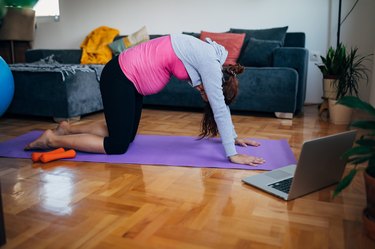
Cat-cow is typically done on hands and knees, but if that's uncomfortable, you can also try a standing variation.
"To make it most effective, I recommend doing the movement slowly and gently," Shipley says. "It's key to feel what your body needs and not push past pain or stiffness. Work within the range that you have available at that moment, and in time it can improve."
You'll reap the biggest tension-relieving benefits when you do the pose regularly.
"I'd recommend doing it one to three times per day," Shipley says. Blamphin suggests trying it once when you first wake up (you'll get the added bonus of relieving back tension) and again right before bed.
Traditional Cat-Cow
- On a carpeted floor, yoga mat or towel, get onto hands and knees. Align your wrists directly under your shoulders and your knees directly under your hips. Keep your head in a neutral position with your gaze pointed downward.
- Drop your belly towards the floor or mat while inhaling. Lift your chin and chest while looking towards the ceiling. You can drop your belly fully to create a deep curve in your back if it's comfortable to do so. Move slower or more gently if a full curve would be uncomfortable, which may be the case during late pregnancy.
- Exhale while pulling your belly towards your spine and rounding your back. Shift the crown of your head so it's facing the floor.
- Repeat the cycle five times.
Standing Cat-Cow
A standing variation of cat-cow can help reduce pelvic tension if getting onto your hands and knees is uncomfortable, or if you have abdominal separation or diastasis recti, Blamphin notes.
"You can do that just by bending over the back of a chair or countertop and rounding your neck and pelvis throughout the day as needed," Shipley says. "This will release any lower back pain or pressure that comes up and could potentially also help with your bladder."
Is this an emergency? If you are experiencing serious medical symptoms, please see the National Library of Medicine’s list of signs you need emergency medical attention or call 911.
